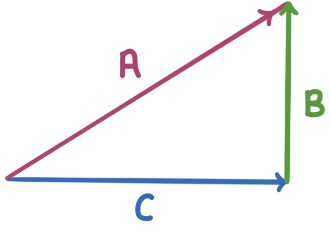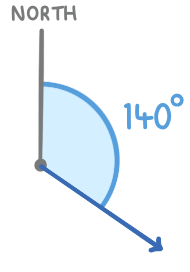Resolving Vectors & Scale Drawings
This lesson covers:
1How to use scale drawings to find the resultant force on an object
2How to resolve vectors into their horizontal and vertical components

Which of the three force vectors is the resultant force?
A
B
C
|

A 'bearing' is an angle measured clockwise from the north direction.
For example, in the image above, the vector (the dark blue arrow) is at a bearing of 140°, because it's 140° clockwise from north.
A boat is crossing a river, with its engine exerting a force of 90 N north. The river is pushing the boat sideways with a force of 50 N east.
Using paper, pencil, and protractor, draw a vector diagram to find the resultant force, and bearing from north.
(we suggest using grid paper and a scale of 1 cm = 10 N)
(click 'Continue' when you're ready to check your answer)
|
The motion of a sailing boat is affected by both the wind and the ocean current. A boat is experiencing a southerly wind of 70 N, and an easterly current of 120 N.
Using paper, pencil, and a protractor, draw a vector diagram to find the resultant force, and bearing from north.
(we suggest using grid paper and a scale of 1 cm = 10 N)
(click 'Continue' when you're ready to check your answer)
|